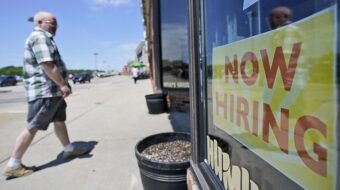Once upon a time, when a company went bankrupt, everyone took a hit: workers lost wages, stockholders got killed and the creditors got only tiny bits of what was left. The law guaranteed that it would work this way.
Once upon a time, what workers did not lose was their pensions. Because their pensions were already taken out of their wages and held in their names for them it seemed only fair. Again, the law guaranteed that it would work this way.
“But not this time. Stevie the Rat has a different plan for GM: grab the pension funds to pay off Morgan and Citi,” wrote Greg Palast, the economist and journalist, recently.
Palast, the author of The New York Times bestseller, “The Best Democracy Money Can Buy” was referring to Steven Rattner, Barack Obama’s ‘Car Czar’ — the man who basically designed the GM bankruptcy plan.
The Rattner scheme involves insisting that the court erase GM’s obligations to the health insurance fund for its retirees. A percentage of the cash in the insurance fund could be replaced by GM stock. “The percentage may be 17 percent or 25 percent. Whatever, 17 percent or 25 percent is worth, well just try paying for your dialysis with 50 shares of bankrupt auto stock.”
The Rattner plan is not bad news for everyone, however.
Two privileged GM lenders, Morgan and Citibank, get 100 percent of their loans to GM paid back in cold hard cash — cash in the amount of $6 billion.
One of the most important points Palast makes is that almost any fiddling around with pension funds is illegal.
He notes that in 1974 Congress passed the Employee Retirement Income Security Act which makes it illegal to seize workers’ pension funds (whether monthly payments or health insurance) any more than you can seize their private bank accounts. “And that’s because they are the same thing: workers give up wages in return for retirement benefits,” said Palast.
He pointed out that the law explicitly requires that companies hold retirement funds as “fiduciaries.”
“The primary responsibility of fiduciaries,” it reads, “is to run the plan solely in the interest of participants for the exclusive purpose of providing benefits.”
“Every business in America that runs short of cash would love to dip into retirement kitties, but it’s not their money any more than a banker can seize your account when the bank’s a little short,” said Palast.
He noted that, in effect, money is transferred from pension funds into the coffers of Morgan and Citibank. “The money for an elderly auto worker’s spleen is siphoned off to feed the TARP babies. Workers go without lung transplants so Dimon and Rubin (Morgan and Citibank CEO’s) can pimp out their ride.”
The argument he makes is that filching GM’s pension assets doesn’t become legal because the cash due the fund is replaced with stock.
The Congress actually anticipated such schemes when it wrote a clause into the original law that said, “fiduciaries must act prudently and must diversify the plan’s investments in order to minimize the risk of large losses.”
Putting 100 percent of workers’ funds into a single busted company’s stock, Palast said, is not diversifying for safety.
And, he said, it can open the floodgates to other big companies seeking to drain health care investment funds.
Palast reserves some of his strongest anger for Citibank and Morgan.
He castigates them as recipients of “corporate welfare.” (Together they have gotten a third of a trillion in aid from the U.S. Treasury.) And he asks why only they come out profiting from the GM bankruptcy.
“Is the forced bankruptcy of GM,” Palast asks, “the elimination of tens of thousands of jobs, just a collection action for favored financiers?”











Comments